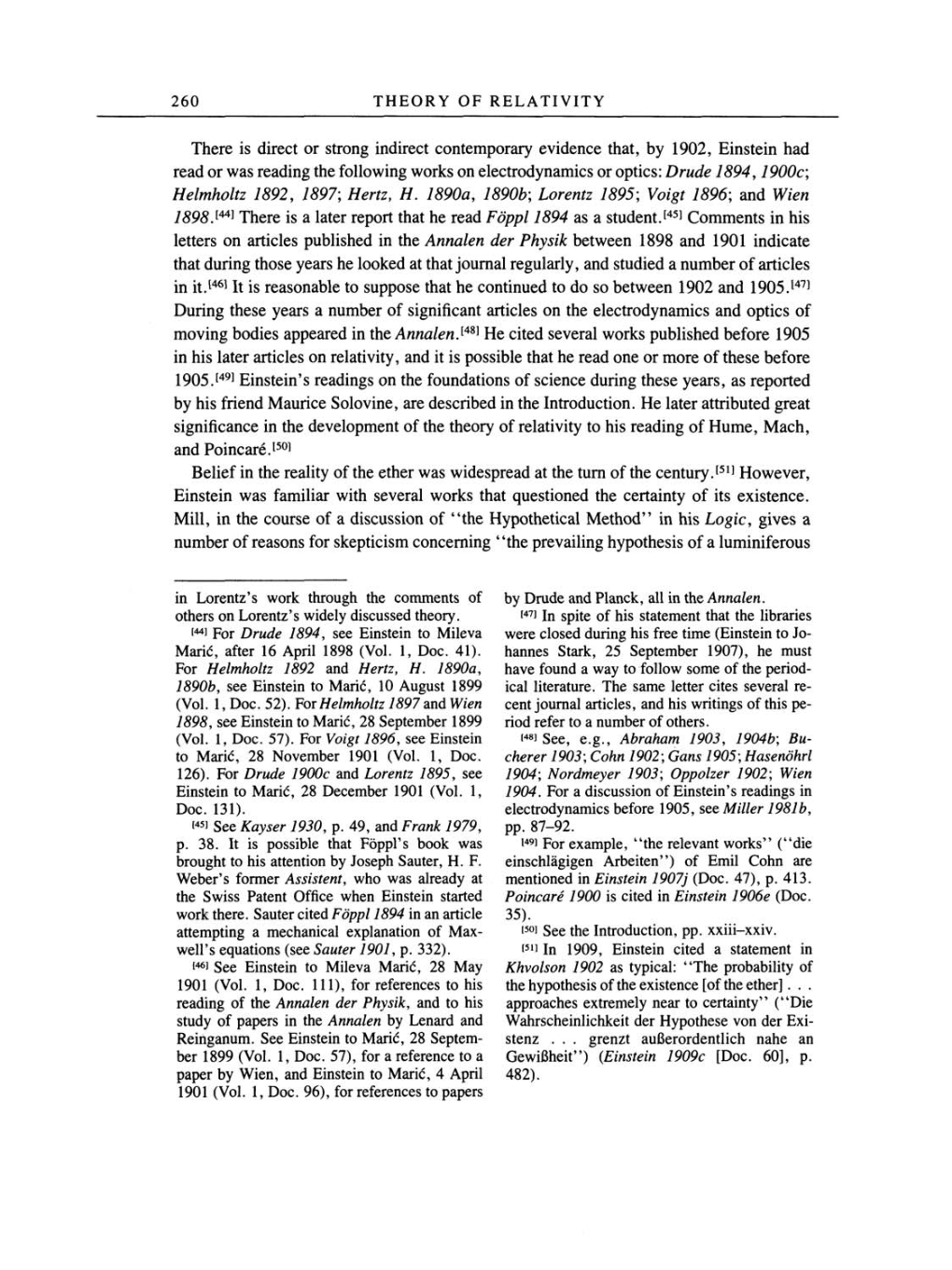260
THEORY
OF RELATIVITY
There
is
direct
or strong
indirect
contemporary
evidence
that,
by
1902,
Einstein had
read
or was reading
the
following
works
on electrodynamics or optics:
Drude
1894, 1900c;
Helmholtz
1892, 1897; Hertz,
H.
1890a, 1890b;
Lorentz
1895;
Voigt
1896;
and Wien
1898.[44]
There
is
a
later
report
that he read
Föppl
1894
as a
student.[45]
Comments in his
letters
on
articles
published
in
the Annalen
der
Physik
between 1898 and
1901 indicate
that
during
those
years
he looked at that
journal regularly,
and
studied
a
number of
articles
in
it.[46]
It
is
reasonable to
suppose
that he continued to do
so
between
1902 and
1905.[47]
During
these
years a
number
of
significant
articles
on
the
electrodynamics
and
optics
of
moving
bodies
appeared
in the
Annalen.[48]
He cited several works
published
before
1905
in his later articles
on relativity,
and it
is
possible
that he read
one or
more
of
these
before
1905.[49]
Einstein's
readings on
the foundations
of
science
during
these
years,
as
reported
by
his friend Maurice
Solovine, are
described
in
the Introduction. He later
attributed
great
significance
in the
development
of
the
theory
of
relativity
to his
reading
of
Hume, Mach,
and Poincare.[50]
Belief
in
the
reality
of
the ether
was widespread
at the turn
of
the
century.[51]
However,
Einstein
was
familiar with several works that
questioned
the
certainty
of
its
existence.
Mill, in the
course
of
a
discussion
of "the
Hypothetical
Method"
in his
Logic,
gives
a
number
of
reasons
for
skepticism concerning
"the
prevailing hypothesis
of
a
luminiferous
in
Lorentz's
work
through
the comments
of
others
on
Lorentz's
widely
discussed
theory.
[44]
For
Drude
1894,
see
Einstein to Mileva
Maric, after
16
April
1898
(Vol. 1,
Doc.
41).
For Helmholtz 1892 and Hertz,
H.
1890a,
1890b, see
Einstein
to
Maric,
10
August
1899
(Vol.
1,
Doc.
52).
For Helmholtz
1897
and Wien
1898, see
Einstein to
Maric,
28
September
1899
(Vol.
1,
Doc.
57).
For
Voigt
1896,
see
Einstein
to
Maric, 28 November 1901
(Vol.
1,
Doc.
126).
For
Drude
1900c and Lorentz
1895,
see
Einstein to Maric, 28 December
1901 (Vol.
1,
Doc.
131).
[45]
See
Kayser 1930,
p.
49,
and
Frank
1979,
p.
38.
It
is
possible
that
Föppl's
book
was
brought to
his attention
by
Joseph
Sauter,
H. F.
Weber's
former
Assistent,
who
was already
at
the Swiss Patent Office when Einstein started
work there. Sauter cited Föppl 1894 in
an
article
attempting a
mechanical
explanation
of
Max-
well's
equations
(see
Sauter
1901,
p.
332).
[46]
See Einstein to Mileva
Maric,
28
May
1901
(Vol. 1,
Doc.
111),
for
references to his
reading
of
the Annalen
der
Physik,
and to his
study
of
papers
in the Annalen
by
Lenard and
Reinganum.
See Einstein
to Maric,
28
Septem-
ber
1899
(Vol.
1,
Doc.
57),
for
a
reference
to
a
paper
by
Wien, and Einstein to
Maric, 4
April
1901 (Vol.
1,
Doc.
96),
for
references
to
papers
by
Drude and Planck, all in the Annalen.
[47]
In
spite
of
his statement that the libraries
were
closed
during
his free time
(Einstein
to
Jo-
hannes
Stark,
25
September 1907),
he must
have found
a way
to follow
some
of
the
period-
ical literature. The
same
letter
cites
several
re-
cent journal articles,
and his
writings
of
this
pe-
riod
refer
to
a
number
of
others.
[48] See,
e.g.,
Abraham
1903, 1904b;
Bu-
cherer
1903; Cohn 1902;
Gans
1905;
Hasenöhrl
1904;
Nordmeyer 1903;
Oppolzer
1902;
Wien
1904. For
a
discussion
of Einstein's
readings
in
electrodynamics
before
1905,
see
Miller
1981b,
pp.
87-92.
[49]
For
example,
"the
relevant
works"
("die
einschlägigen
Arbeiten")
of
Emil Cohn
are
mentioned in
Einstein
1907j (Doc. 47),
p.
413.
Poincare
1900 is
cited in
Einstein
1906e
(Doc.
35).
[50]
See the Introduction,
pp.
xxiii-xxiv.
[51]
In
1909,
Einstein cited
a
statement
in
Khvolson 1902
as typical:
"The
probability
of
the
hypothesis
of
the existence
[of
the
ether]...
approaches extremely near
to
certainty"
("Die
Wahrscheinlichkeit
der
Hypothese von
der
Exi-
stenz
...
grenzt
außerordentlich
nahe
an
Gewißheit")
(Einstein
1909c
[Doc. 60], p.
482).
